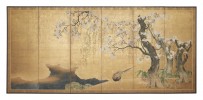
Pheasants under Cherry and Willow Trees and Irises and Mist

Photography by Synthescape, Digital image © Asia Society

Photography by Synthescape, Digital image © Asia Society
Attributed to Kano Ryokei
Pheasants under Cherry and Willow Trees and Irises and Mist
first half 17th century
Japan, Kyoto Prefecture, Nishihonganji
Pair of six-panel folding screens; ink and color on gold leaf on paper
Each, H. 63 x W. 143 1/4 in. (160 x 363.9 cm)
Asia Society, New York: Mr. and Mrs. John D. Rockefeller 3rd Collection, 1979.217.1-2
Licensing inquiries
The three trunks with exposed roots in the foreground of the right-hand screen of this pair is a typical example of the tripartite composition, the sharply defined forms, and the interest in precise details that illustrate the traditional style of the Kano school of painting in the early 17th century. The technique of creating a gold background for screens, by covering the surface with paper-thin sheets of gold foil, dates back to the 14th century. At first, the screens were not painted, but left plain. These screens are believed to have once been part of the interior decoration of the Nishihonganji, a prominent temple in Kyoto. Placed together, the screens illustrate the transition from the spring (the budding cherry, willow, and pheasants) to summer (the blooming irises). These themes are important in Japanese literature and often depicted in yamato-e, "Japanese picture," paintings.

